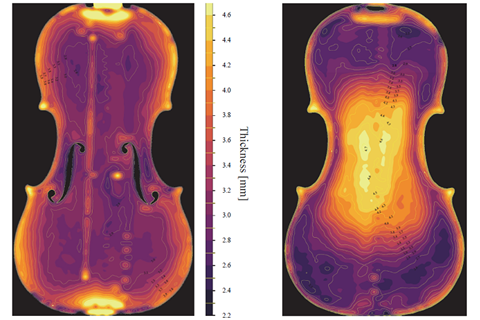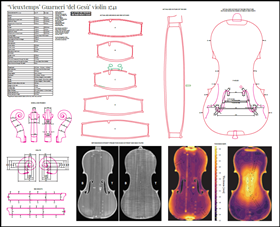Additional measurements including weights and densities of the top and back plates

Recently published, The Strad’s latest addition to its poster collection showcases the ‘Vieuxtemps’ Guarneri ‘del Gesù’. Expert Terry Borman, who has examined the instrument many times, wrote the following in the May 2018 edition of The Strad:
We are providing thickness maps for the belly and back of this instrument. These maps were generated using hundreds of thousands of thickness measurements. Our tests, which compared calliper-derived measurements on test pieces of wood with those obtained from CT scans, show that accuracy is almost identical. The advantage of CT-derived measurements is that the potential for human error is completely removed.
With a calliper any deviation from perfectly perpendicular to the measured point on a plate will give false readings, always thicker than real. Comparisons to Hacklinger gauge measurements are also virtually identical, although it’s difficult to repeat measurements and get the same result with this method, and the gauge has to be calibrated (something most makers don’t bother with). In the end, though, thickness measurements on their own don’t provide as much information as we’d like to believe.
There are four parts to interpreting thickness maps: the thicknesses themselves; the density of the wood used; grain orientation (particularly for the belly); and the thickness distributions. The most important factor is the wood density, because variation from the density of the original will necessitate altering those thicknesses commensurately – denser wood will most likely need thinner values to achieve a somewhat similar effect.
Recent research has shown that, contrary to the long-held opinion that the classical Cremonese makers had access to ‘special’ wood, this does not seem to have been the case. The notion that they benefited from wood with unique properties derived from the Little Ice Age has long since been debunked, as this would have created wood with significantly higher densities than what has been accurately measured in multiple Stradivari and GdG instruments via non-invasive CT quantitative analysis.
Once the densities and thicknesses are known, the next factor is knowing where thickness distributions occur, as this will affect the underlying concept of how a violin functions: much of the violin sound is derived from modal vibrations. The plates (at lower frequencies) vibrate creating ‘signature modes’ and knowing where these changes occur one can attempt to sculpt the modes towards a particular goal.
The following measurements were acquired using CT scans:
Back median density 566gr/litre
Top median density 364gr/litre
Back plate weight 114.3gr
Top plate weight 68.5gr
Luminal volume* 1.97 litres
Treble f-hole volume 443mm2
Bass f-hole volume 447mm2
Total f-hole area volume 890mm2
*Luminal volume = total air volume contained within the violin
The Strad’s poster of the 1741 ‘Vieuxtemps’ Guarneri can still be bought here
Watch: Anne Akiko Meyers plays Rautavaara’s Fantasia on the ‘Vieuxtemps’ Guarneri












































No comments yet